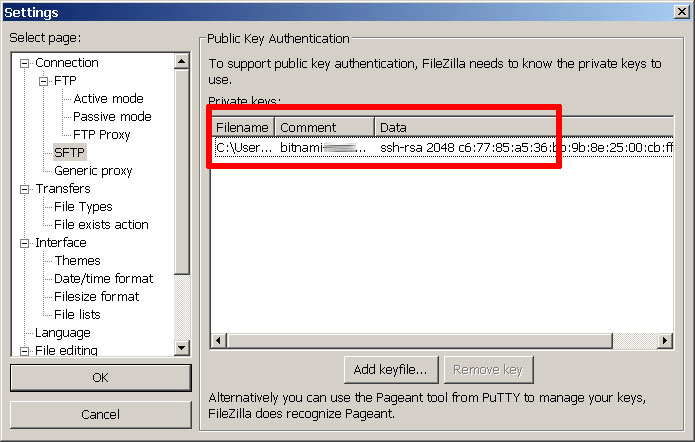Both instructions on this page tell 3/4 of the story: Yar is correct: you only have to go to the SFTP settings page to enter your SSH key (which I had to format as a putty key with a.ppk extension - FileZilla will format a normal ssh private key for you if you let it). Ddd is correct that you have to put your login into 'Normal' mode (but you still also need the key entered on the SFTP settings). But there is one more thing you have to have in your settings - you must allow FileZilla to save passwords. This is in the Preferences - Interface: If you check the box that says 'Do Not Save Passwords' you will not be permitted to use Normal mode, and then your ssh won't be utilized - you will be prompted for a password. So, do all three steps:. Import SSH Key on the SFTP settings page. Do not check the box that says 'Do Not Save Passwords' (i.e., allow saving passwords).
Mac Ssh Key

Filezilla Server For Mac
Use Normal mode in the General tab of the server profile settings. You don't need.ppk or.pem keys. Add your private key to the SSH agent. In Mac, this is ssh-add /.ssh/your private key - if you haven't created SSH keys then run this command first ssh-keygen -t rsa -f /.ssh/give a name for your keys -C 'your email'.

1) Open FileZilla 2) Type host: sftp://host ip address you want to connect to 3) Type username: your username 4) Leave password and port fields empty 5) Click Quickconnect FileZilla will be able to use the keys you've loaded in the SSH agent automatically.
SSH’ing Into Your Mac 5 Terminal. I use SSH a lot, it stands for Secure Shell and its main purpose is to connect to other computers, or servers, over a secure connection which you can use to manage the remote computer. For a general overview I recommend reading this Wikipedia article. For this article you do need to be a. Feb 10, 2018 - In this tutorial, you will learn how to use SFTP with FileZilla to. Windows users: How To Use SSH Keys with PuTTY on RunCloud; Mac. I need to transfer a text file to a remote PC (freeSSH) using SFTP and SSH from a Mac host. These two are connected in a local network. So is there a way to run an SFTP command (with the username and password provided) from inside the Bash script?
Mac Ssh Server
Every previous answer is working (as google suggest too), but they are dirty and inelegant. The right way to change the listening port for a launchd handled service on Mac OS X is to make the changes the dedicated keys available in ssh.plist So the solution is as simple as to use the port number instead of the service name. An excerpt from my edited /System/Library/LaunchDaemons/ssh.plist: Sockets Listeners SockServiceName 22022 SockFamily IPv4 Bonjour 22022 Note: to be able to edit this file on El Capitan, Sierra and probably future versions as well, you need to disable SIP (System Integrity Protection). The above edit will also force sshd to listen only over IPV4.

After making any changes to ssh.plist, the file must be reloaded as follows: sudo launchctl unload /System/Library/LaunchDaemons/ssh.plist sudo launchctl load /System/Library/LaunchDaemons/ssh.plist Note that using launchctl stop. And launchctl start. Will NOT reload this file.
The man page with more information can be found by typing man launchd.plist or using. From what I read (and experienced) so far, there are three main methods which can be used:.
change the setting in the ssh.plist file;. change the setting in the /etc/services file;. change the setting in the /etc/sshd.conf file. Another way to do it, which I personally by far prefer to all and each of these methods, because it avoids messing around with Mac OS X system files is using socat to redirect port 22 to whichever port you want.
I couldn't see this documented anywhere properly in a man page, but if you want to do nothing more than add an extra listener, you can use an array of listeners and have an extra dict. This doesn't require editing /etc/services if you use the port directly (but remember to open up the port on your firewall!) Listeners Bonjour ssh sftp-ssh SockServiceName ssh SockServiceName 22222.